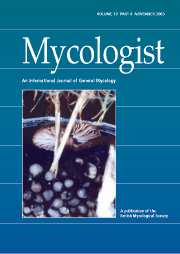Crossref Citations
This article has been cited by the following publications. This list is generated based on data provided by
Crossref.
2000.
21st Century Guidebook to Fungi.
p.
325.
Convey, P.
Chown, S. L.
Wasley, J.
and
Bergstrom, D. M.
2006.
Trends in Antarctic Terrestrial and Limnetic Ecosystems.
p.
101.
Honegger, Rosmarie
and
Zippler, Undine
2007.
Mating systems in representatives of Parmeliaceae, Ramalinaceae and Physciaceae (Lecanoromycetes, lichen-forming ascomycetes).
Mycological Research,
Vol. 111,
Issue. 4,
p.
424.
Ruisi, Serena
Barreca, Donatella
Selbmann, Laura
Zucconi, Laura
and
Onofri, Silvano
2007.
Fungi in Antarctica.
Reviews in Environmental Science and Bio/Technology,
Vol. 6,
Issue. 1-3,
p.
127.
Ruisi, Serena
Barreca, Donatella
Selbmann, Laura
Zucconi, Laura
and
Onofri, Silvano
2007.
Life in Extreme Environments.
p.
161.
Edman, Mattias
Eriksson, Anna‐Maria
and
Villard, Marc‐André
2008.
Effects of selection cutting on the abundance and fertility of indicator lichens Lobaria pulmonaria and Lobaria quercizans.
Journal of Applied Ecology,
Vol. 45,
Issue. 1,
p.
26.
Fehrer, Judith
Slavíková‐Bayerová, Štěpánka
and
Orange, Alan
2008.
Large genetic divergence of new, morphologically similar species of sterile lichens from Europe (Lepraria, Stereocaulaceae, Ascomycota): concordance of DNA sequence data with secondary metabolites.
Cladistics,
Vol. 24,
Issue. 4,
p.
443.
Dyer, Paul S.
2008.
Evolutionary Biology: Genomic Clues to Original Sex in Fungi.
Current Biology,
Vol. 18,
Issue. 5,
p.
R207.
Frisvad, Jens C.
2008.
Psychrophiles: from Biodiversity to Biotechnology.
p.
137.
Jairus, Kadi
Lõhmus, Asko
and
Lõhmus, Piret
2009.
Lichen acclimatization on retention trees: a conservation physiology lesson.
Journal of Applied Ecology,
Vol. 46,
Issue. 4,
p.
930.
Geml, József
Kauff, Frank
Brochmann, Christian
and
Taylor, D. L.
2010.
Surviving climate changes: high genetic diversity and transoceanic gene flow in two arctic–alpine lichens, Flavocetraria cucullata and F. nivalis (Parmeliaceae, Ascomycota).
Journal of Biogeography,
Vol. 37,
Issue. 8,
p.
1529.
WERTH, Silke
2010.
Population genetics of lichen-forming fungi – a review.
The Lichenologist,
Vol. 42,
Issue. 5,
p.
499.
Werth, Silke
2011.
Biogeography of Microscopic Organisms.
p.
191.
Ellis, C. J.
and
Yahr, R.
2011.
Climate Change, Ecology and Systematics.
p.
457.
DAL GRANDE, F.
WIDMER, I.
WAGNER, H.H.
and
SCHEIDEGGER, C.
2012.
Vertical and horizontal photobiont transmission within populations of a lichen symbiosis.
Molecular Ecology,
Vol. 21,
Issue. 13,
p.
3159.
Honegger, R.
2012.
Fungal Associations.
p.
287.
Martínez, Isabel
Flores, Tatiana
Otálora, Mónica A.G.
Belinchón, Rocio
Prieto, María
Aragón, Gregorio
and
Escudero, Adrián
2012.
Multiple-scale environmental modulation of lichen reproduction.
Fungal Biology,
Vol. 116,
Issue. 11,
p.
1192.
Jones, T. C.
Hogg, I. D.
Wilkins, R. J.
and
Green, T. G. A.
2013.
Photobiont selectivity for lichens and evidence for a possible glacial refugium in the Ross Sea Region, Antarctica.
Polar Biology,
Vol. 36,
Issue. 6,
p.
767.
Heim, Amy
and
Lundholm, Jeremy
2013.
Cladonia lichens on extensive green roofs: evapotranspiration, substrate temperature, and albedo.
F1000Research,
Vol. 2,
Issue. ,
p.
274.
Whittle, Carrie A.
and
Johannesson, Hanna
2013.
Evolutionary Dynamics of Sex-Biased Genes in a Hermaphrodite Fungus.
Molecular Biology and Evolution,
Vol. 30,
Issue. 11,
p.
2435.


